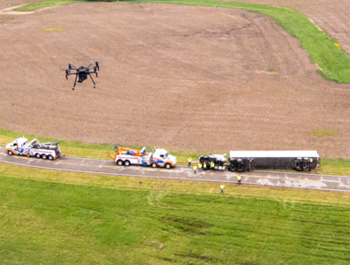Ohio working on aircraft tracking system
VW independent staff/submitted information
COLUMBUS — As the number of drones grow, so do concerns about how to keep airspace safe for both crewed and uncrewed aircraft. Ohio is pioneering technology to do just that.
At low altitudes, detecting manned air traffic with traditional radar is much more difficult due to the presence of ground obstructions such as trees, houses, cars, and other low-flying objects such as birds and insect swarms. Since 2018, the Ohio Department of Transportation Office of Statewide Planning and Research has been working with the Federal Aviation Administration (FAA), DriveOhio/FlyOhio, the Ohio Unmanned Aircraft Systems (UAS) Center, Ohio State University, and industry to develop and deploy a “detect and avoid” system to track drones, as a public service, and keep them from colliding with aircraft that operate at lower altitudes like medical helicopters or crop dusters. This is a first in an urban setting.

The Uncrewed Traffic Management system includes three ground-based radar locations in central Ohio. A drone operator requests clearance to fly, much like an aircraft pilot would, and is given permission to use the airspace from the FAA. Both drone pilots and manned aircraft pilots would be able to see each other and safely share the airspace.
“It gives drones an understanding of where they are in the airspace, who’s around them, and what they can do to essentially safely navigate from A to B all while giving manned traffic the priority,” said Dr. Matt McCrink, lead scientist for Ohio State’s research team.
As of May 2022, there are more than 854,000 drones registered with the Federal Aviation Administration (FAA). Currently, the FAA requires all unmanned aircraft be operated within sight of the operator.
“The promise of drone deliveries has been around for some time, but that key infrastructure to support that has not existed and so ODOT is at the forefront of essentially establishing what that infrastructure looks like, how we can scale it, grow it, and incorporate it with the existing manned traffic control systems as well,” McCrink said.
The development of this system will provide affordable and reliable needed protections against airborne hazards for operators to safely fly beyond visual line-of-sight without ground observers, allowing drone technology to grow in Ohio.
“The last mile package delivery is what the future holds. The FedExs, UPSs, Amazons – that two-hour delivery that they guarantee, this technology will support that,” said Richard Fox, airspace manager for the Ohio UAS Center.
Aside from product deliveries, drones can also provide valuable information to emergency crews at a crash scene. The system was recently used as part of a multi-jurisdictional incident management training operation using drones, believed to be the first in the world. The exercise simulated a crash involving a semi-truck in Logan County. The drones provided airspace support by transmitting live video to emergency dispatchers, first responders, and the ODOT Traffic Management Center in Columbus giving them an “eye in the sky.” However, when a medical helicopter was called to the scene to shuttle a victim to the hospital, the system was able to alert the drone operators so they could clear the airspace.
“ODOT’s mission is to provide safe and easy movement of people and goods from place to place and that isn’t limited to ground level,” ODOT Director Jack Marchbanks said. “From researchers to drone pilots and aviation experts, our employees work hard each day to ensure that Ohio is the premier place to develop and grow this quickly emerging industry.”
Advanced air mobility, which uses electric vertical takeoff and landing aircraft to easily move people and cargo, is another next major step in drone technology. An economic impact study found that over the next 25 years, advanced air mobility could benefit the Ohio economy to the tune of $13 billion, 15,000 additional jobs, and $2.5 billion in tax revenues.
“I think as we learn how to do the smaller operations and manage the lower altitude airspace safe and efficiently for UAS, you’re going to see the industry grow,” said Dr. Sean Calhoun with CAL Analytics. “Everything from disaster response, package delivery to cargo and eventually air taxis is where we’re heading, which will revolutionize the transportation and logistics industries.”
Calhoun added that Ohio has positioned itself in the right place to remain a leader in this emerging technology.
POSTED: 08/23/22 at 3:40 am. FILED UNDER: News







